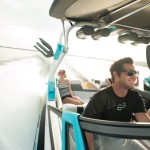Maintaining Longevity in Wakeboarding
I think everyone that has been riding for a few years will agree that wakeboarding can be hard on your joints, particularly your knees and ankles. When you look at Pro and Amateur riders who have had a long career in the sport, there are certain points to learn from their successes to protect and strengthen your own joints.
Stretch before you ride.
Although most people don’t do this, it’s the easiest way to avoid possible injury. Spend at least two minutes stretching; make sure to stretch your Hamstrings, Quads, Ankles, Shoulders, and Neck in your routine.
Protecting Knees
Many knee injuries are caused from having an improper stance or riding position on the board. I see a lot of wake boarders who ride with their front let straight, and their rear leg bent while they are riding around, and cutting into the wake. As they get into the air, they still have their front leg locked and tend to land that way, which increases the chances for knee injury. Try to get in the habit of riding with both knees bent all of the time. Besides protecting your knees, it will make the board more responsive by not riding tail heavy.
Protecting Ankles
Be aware of buying a board that is overly wide, as they tend to hyperextend your ankle on toe heavy or heel heavy landings. The wider the board is, the more leverage the outside edge has to hyperextend your ankle. I’ve personally had my ankle over extended a lot of times from wakeboarding. I now try to focus on keeping my ankles tense and locked into place as I leave the wake to try to avoid these types of injuries.
Absorb the Landings.
A lot of riders don’t absorb the impact of landing properly, and will only slightly bend their knees upon landing. Others will keep their knees rigid, absorbing the shock with their lower back by breaking at the waist. Be sure to properly absorb the landing by going through a full range of motion with your knees, until your butt nearly touches the water, to preserve your ACL and knee cartilage, especially on big jumps. Inward movement of the knee on landings should also be avoided. Always try to land softly, think of the phrases “light as a feather”, “straight as an arrow” to encourage proper body position.
Stance
A few years ago, it was fashionable in the pro wakeboard circles to have a stance width that was as wide as possible. After a while, these riders were having knee and hip problems. Your stance on the board is really something that is dependant on how your own knees work, and should be set up accordingly. The best way to do this is to have your board placed on the ground in front of you, and practice doing floor jumps directly behind it. Absorb some of the landings with your feet at shoulder width, and some with your feet wider than shoulder width apart. Position the width of the bindings on your board as a result of what feels most natural to you. The angle of the bindings should be set using the same method, most people find it comfortable to ride with both feet pointing outward, or duck footed, about 10 to 15 degrees.
Wake size
Avoid riding a huge wake all of the time, since it takes a toll on your body. Give your joints a rest from time to time by riding a smaller wake. It’s also a good opportunity to learn things like backside 180’s and spins, where a large wake isn’t needed and can actually be a hindrance.
Off Season
In the off season, concentrate on exercises that build muscle around your knee and ankle to help support them. Physical therapists recommend weight room activities that build a balance of strength between the Hamstrings and Quads. Training activities like Leg Extensions, Leg curls, and jumping exercises have been shown to prevent undue stress on the ACL and the knee as a whole. Balance exercises such as the Indo board, build ankle strength, as well as toe and heel lifts, and outward and inward ankle rolls. Also, readily available joint strengthening vitamin supplements such as Glucosamine Chondroitin are recommended by sports medicine therapists to promote joint health and serve as a building block for cartilage and connective tissue.


Leave a Reply
Want to join the discussion?Feel free to contribute!